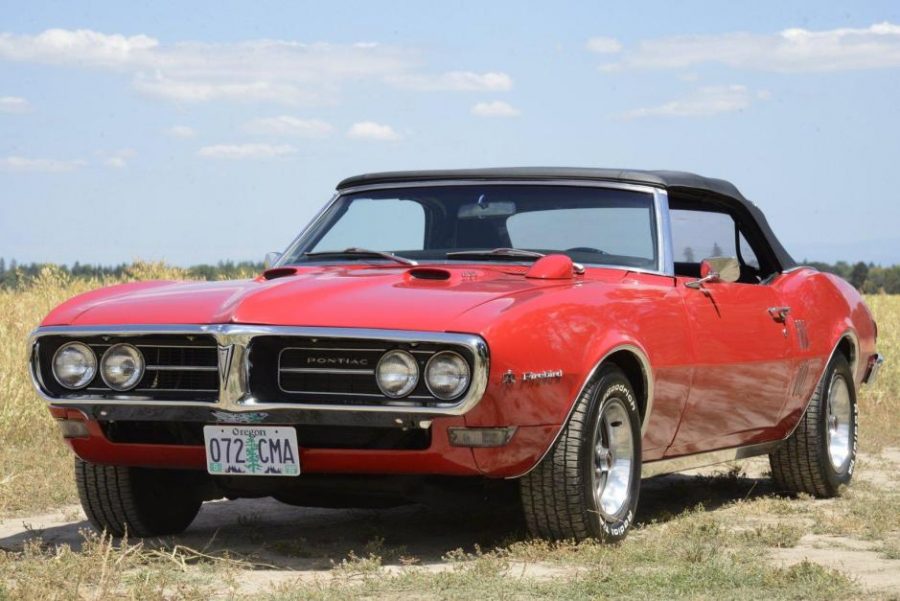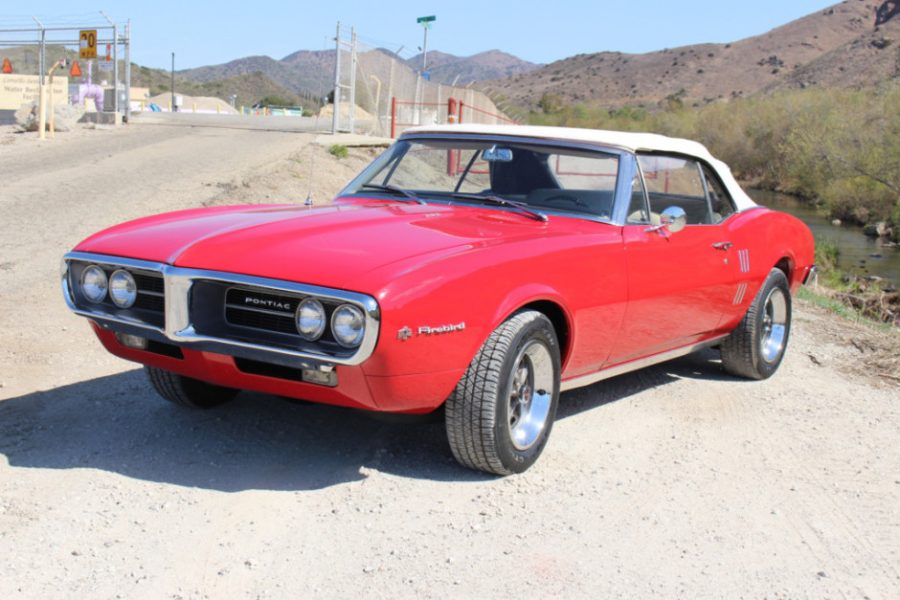The Mighty Bird
November 6, 2020
The Mighty Bird
The 1967 through 1979 Firebirds are straight zingers on the street and track. The Firebird was a hit in the muscle car market leaving its mark on American culture forever. It was originally a consolation car because General Motors (G.M.) wouldn’t let Pontiac make a two-seat sports car. Their reasoning for this was it would hurt the almighty Chevrolet Corvette.
The 1967 Firebird was introduced on the F-body platform, which is a type of chassis, along with its brotherly competition the Chevrolet Camaro. Its main competitor though, was the Ford Mustang.
The Firebird was the smallest car in the Pontiac muscle car lineup; however, still available as a convertible. The engines available were the 6 cylinder, 326ci (ci means cubic inch and is a measure of engine size) and the top dog, the 400ci. The 1967 Firebird in my opinion, handled awesome for its time and better than its cousin the GTO.
1968 was a very similar iteration with minor differences including a deleted wing window. and side marker lights to comply with new regulations. There was also a new Pontiac emblem on the rear quarter panel. The mean and lean 326ci motor was replaced with a hard-hitting 350ci. The Ram Air ll was introduced as the most powerful motor in the meanest Firebirds.
In 1969, the Firebird received a general appearance facelift, as well as introducing the Trans Am package–an ultra-rare option–with only 697 made (eight convertibles). For the Trans Am, Ram Air lll was standard equipment. However, Pontiac decided to install the optional legendary Ram Air lV in 55 out of the 697. Also note that the Trans Am was first offered in 1969 then offered all the subsequent years.
The Firebird in 1970 received a total redesign with an exquisite new look. The motor options were unchanged from the previous year. There was a 1970 ½ 455 H.O. (high output) version that was the biggest, baddest motor ever placed in a Firebird. Unfortunately, they dropped the convertible, and it was not to be offered until the third generation in the 1980’s.
1971 was aesthetically the same as the 1970. The same engines were available from the previous year, including the robust 455 H.O., yet they dropped the Ram Air III.
If you put the 1971 and 1972 side-by-side, they would look exactly the same. Unfortunately, 1972 was the last year of the awesome Ram Air IV.
The 1973 year marked a milestone of mechanical perfection with the introduction of 455 Super Duty. The 455ci S.D. had a strengthened block 4-bolt main caps, along with some other strengthening features–debatably, making it the most high performance Pontiac engine ever made.
Safety standards introduced in 1974 forced manufacturers to make clunkier, safer front bumpers. The 1974 Firebird with its revised front end looked great; however, some cars unfortunately had a fate worse than death having horrible looking front ends. This would be the last year of the glorious 455ci S.D.
In 1975 The body received minor improvements including different rear windows as well as other changes. Engine options remained the same, fortunately still offering the powerful 455ci.
1976 was the last year for the breathtaking 455ci. Pontiac celebrated their 50th anniversary by making a special edition Trans Ams that wore a graphic package and a high performance 400ci or 455ci.
1977 was a special year for the Trans Am featured in the movie Smokey and the Bandit along with the best motor available the W72 400 producing 200 rear wheel horsepower, as well as having a sleek new bumper. The cars meant for higher altitude were equipped with the Oldsmobile 403 motor said to have better torque numbers.
1978 was very similar to the 1977 model with a slightly different grill going with a crosshatch pattern opposed to a honeycomb pattern. The 400ci was only available with four speed manual Trans Am. Another cool feature was putting 6x heads on the 400ci reaping performance gains.
1979 was the beginning of the end for high performance Firebirds that would not be produced again until early 2000’s. The 79 model had an altered front end. This was the last year of the 400 and 350.
My favorite is the 1967 Firebird due to its wing window and its elegant body lines. What makes a Firebird mean is the potato-potato-potato sound of extreme cam. The Bird is mighty because of staggering engines and stunning looks
Photo Credits
https://www.smokymountaintraders.com/cars-for-sale/172/1968-pontiac-firebird-400
https://bringatrailer.com/listing/1968-pontiac-firebird-14/
https://bringatrailer.com/listing/1967-pontiac-firebird-2/
barrett-jackson.com/Events/Event/Details/1969-PONTIAC-FIREBIRD-TRANS-AM-PROTOTYPE-180191
https://www.mecum.com/lots/FL0114-173
913/1970-pontiac-trans-am-ram-air-iv/
https://www.mecum.com/lots/FL0117-269429/1971-pontiac-trans-am/
https://www.pinterest.com/pin/643170390508143142/
https://americancollectors.com/articles/1973-pontiac-transam-sd-455-video/
https://www.autabuy.com/details/?vid=36645726
https://www.hemmings.com/stories/article/the-accidental-muscle-car-1975-pontiac-firebird
https://www.hagerty.com/media/buying-and-selling/bandit-trans-am-alternatives/
https://bringatrailer.com/listing/1977-pontiac-trans-am-2/
https://bringatrailer.com/listing/1978-pontiac-firebird-6/
https://www.hotrod.com/articles/hppp-1002-1979-pontiac-trans-am-2/






